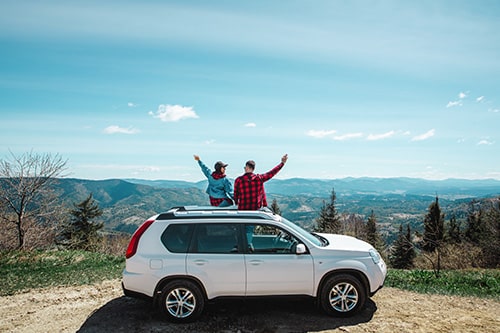
It’s possible to use certain SUVs to venture off-road. But you will likely need a four-wheel drive (4WD) SUV for serious off-roading.
Let’s discuss SUVs and off-roading, the drivetrains (2WD, AWD, and 4WD), and what each means for your off-road performance.
Which SUVs are Okay for Off-Roading?
Within the automotive industry, the term “SUV” (sports utility vehicle) can have a broad definition. Most SUVs are essentially cars with higher ground clearance and a hatchback look, and any vehicle that wears the SUV designation will share characteristics, including:
- Hauling and towing ability
- Spaciousness
- Flexibility
- Potentially some off-roading abilities
While traditional, rugged, body-on-frame SUVs—like the Toyota 4Runner and Ford Bronco—were built to go off-road, the newer car-based SUVs may not have the same capability.
To further blur the lines, most car-based SUVs and crossovers offer full or partial all-wheel drive (AWD) systems that open the door to light off-roading. Such vehicles may be able to handle rugged terrain.
Moreover, SUVs with four-wheel drive (4WD) systems can do serious off-roading to varying degrees. But if the SUV is of the two-wheel-drive (2WD) type, it’s good to say it won’t suit off-roading unless you add some modifications.
Four-Wheel Drive (4WD) SUVs and Off-Roading
Not all SUVs have a 4WD system. But most 4WD vehicles will be an SUV.
4WD (or 4×4) refers to a drivetrain system where the engine sends power to all four wheels. Contrary to popular belief, a 4WD isn’t a class or category of vehicle; it’s just the drivetrain designation. As power is sent to all four wheels, a 4WD can help your vehicle master challenging terrains.
4WD is of two types: full-time and part-time.
About Full-Time 4WD SUVs
The full-time 4WD system is usually found on the masterful, archetypal off-road SUVs, such as:
- Jeep Wrangler
- Toyota Land Cruiser
- Mercedes-Benz G-Class
- Land Rover Defender
These SUVs have a full-time 4WD system that can’t be turned off. They are only suitable for drivers rarely traveling on paved roads.
Part-Time 4WD SUVs Offer the Best of Both Worlds
If you venture on paved roads, you’ll be best suited with a more conventional part-time 4WD system that you can turn off and on as needed.
While full-time 4WD SUVs offer around-the-clock four-wheel performance, part-time 4WD allows you to choose the best drivetrain mode for your driving situation. This offers you more control and flexibility behind the wheel.
For example, if you’re driving a Toyota 4Runner to work during weekdays, you can switch the SUV to rear-wheel drive mode. But when you venture off-road on the weekend, you can use the center differential to create a mechanical lock between your rear and front wheels to activate 4WD.
AWD SUVs vs. 4WD SUVs
All-wheel drive (AWD) vehicles represent a much larger category of vehicles as this drivetrain isn’t limited to SUVs.
While often confused with 4WD, AWD systems function differently and offer unique advantages.
- An AWD system instinctively, automatically, and electronically sends power to every wheel as needed. These systems utilize a variable connection that your vehicle can seamlessly adjust at any speed on the fly. In contrast, 4WD connects your rear and front wheels through a transfer case that evenly splits the power and is only designed to be used at low speeds and in the most challenging terrains.
- 4WD vehicles shine the brightest in the most rugged off-road conditions, they aren’t as useful in normal, day-to-day driving. AWD vehicles are designed to bolster traction and grip in almost all situations but may not be suitable for really rugged and challenging off-road conditions.
SUVs for Off-roading: In a Nutshell
As you can see, the entire definition of an SUV has changed and evolved. Today, the expanded definition of an SUV includes car-based crossovers and hybrid vehicles. And these vehicles are much more likely to have an AWD drivetrain that automatically alters the traction requirements based on your driving needs.
For off-roading:
- Most drivers do not need a true full-time 4WD SUV and can find the most flexibility and performance in a part-time 4WD SUV.
- AWD SUVs may be capable of light off-roading.
- You’re out of luck with 2WD unless you have a modified SUV with such a drivetrain.
Contact Outlander Motorsports for Modified SUV & Off-Road Modifications
At Outlander Motorsports, we are your local modified SUV experts. Whether your SUV is a full-time or part-time 4WD or has an AWD drivetrain, we can elevate it to the next level! In addition to creating modified SUVs, we offer a vast range of the best and most premium accessories for SUVs.
In any case, our off-roading experts will help you create the best-modified SUV for your driving habits. Call us at (925) 839-4144 or stop by to see us at 1424 Shell Avenue, Suite D, Martinez, CA 94553.